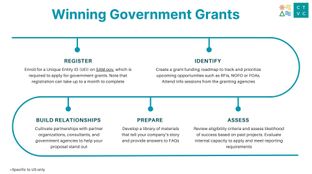
🌎 Get ready with me: Government grants edition 💅💵
A founder’s guide to winning non-dilutive funding with Elemental Excelerator
This week we “talked trash” with Matanya Horowitz, Founder of AMP Robotics, about his vision to transform material use and recycling through deep learning and robotics.

This week we “talked trash” with Matanya Horowitz, Founder of AMP Robotics, about his vision to transform material use and recycling through deep learning and robotics. AMP just announced its $55M Series B raise led by XN, and joined by GV, Valor Equity Partners and return backers Sequoia, Sidewalk Infrastructure Partners, Congruent, and Closed Loop. It’s a powerhouse of investors, and Matanya paints a compelling picture for how AMP’s disruption of the unit economics of recycling will revolutionize material use far and wide.
You just closed a $55m Series B. Congratulations! Take us back in time – how did AMP Robotics get started?
I’ve always been fascinated by robotics and was studying for my PhD at Caltech, while looking for applications of deep learning in industry. Recycling was particularly exciting as the sector is beleaguered by a core technical challenge: the inconsistency of the material stream during sorting. The goal is to create this pure stream of #1 or #2 plastics or cardboard, but every item is smashed, folded, or dirty in some way. This inconsistency has prevented much of existing manufacturing automation from entering the recycling industry, but is a great fit for new deep learning capabilities.
I got really excited when I looked at the unit economics for recycling facilities – these waste materials really do have value. A lot of people think that recycling is driven by some sort of governmental mandate. It’s not a mandate so much as economics. But the cost of sorting this inconsistent waste erodes away most of the value. The materials might be worth $50 or $100 a ton, but the cost of just running the recycling facility nets out to $80 a ton. I got excited about the opportunity for automation to reduce the cost of sorting, and significantly change the unit economics of these recycling facilities.
So I wrapped up my PhD as quickly as I could, and was fortunate to get some government grants and the National Science Foundation SBIR to start the company in 2015. We built (and broke) a bunch of robots and eventually got to something that started to work.
What does the waste and recycling market look like today and what are the challenges you’re solving for?
Today’s industry has been defined by one major event: Southeast Asian markets stopped importing global waste. North America and Europe used to send a majority of our waste to buyers in China in particular, where these markets had a huge need for raw commodities and buyers were so hungry for material that they were willing to accept low quality. Unfortunately, after salvaging the value, they’d basically throw the garbage in rivers, creating some pretty big environmental problems. Different governments stepped in to shut down these markets, and either banned the import of recycled materials or established very high standards for quality. As a result, there’s a glut of low quality recyclable material in the market and prices have been driven down.
This creates an interesting challenge. Recycling facilities typically have two avenues to improve their quality: they can either (1) invest a lot of capital in infrastructure to restructure processes or (2) hire a lot of people to manually sort everything. With our robotic system, we’ve created a third way: a system that costs and functions a lot like hiring a person. Deployment is quick and doesn’t require retrofitting of their existing lines, and takes up roughly the footprint of a person.
Are you focused in expanding domestic markets, or reopening international trade?
The buyers of our equipment are certainly focused in the US, but we have systems deployed internationally in Canada, Japan, and Europe. The ultimate goal is a liquid commodity market where buyers can be assured of quality. Our vision system has a role to play in certifying the quality of various material streams, and our robots can improve the quality of sorting and drive down costs. But we’re not there yet, and AMP is still a fairly small player in the global industry.
What does AMP’s robot look like, and what can the AI do?
Our core technology is a vision system for material identification. It is built on a color camera connected to a GPU which performs inference using a neural network to identify, for example, bottles from cans.
Our main product, Cortex, uses that information for sorting – though it could also be used for other purposes like business intelligence. At the front of the conveyor belt, our vision system looks at the material and sends a signal to the robot to sort the material into the facility’s existing infrastructure, like a chute or bin. The robot is very fast, so it sits inside a safety cage where it’s bolted onto the existing conveyor belt and takes up roughly the footprint of a person who might have otherwise needed to be there.
Existing industry infrastructure is essentially mining machinery adapted for recycling. They use physical properties of the material to coarsely separate it. Those machines can be very high throughput, but lose out on high accuracy. As such, recycling facilities have to augment these machines with people to clean up all the mistakes that pass through. That’s the kind of work that our robots can do – we fit them around those existing screens.
Who are the stakeholders in the waste management ecosystem?
There are a lot of different stakeholders with their own incentives and perspectives. At the start, you have a huge range of creators of waste, from apartment buildings to stadiums to airports, who all have different hauling contracts. The waste haulers are responsible for moving that material to a landfill, recycling facility, incinerator, or other end destination. For landfills and incinerators, the material’s life usually ends there. For recycling facilities, the material gets separated out by commodity type and then sold to metal smelters, paper mills, or plastics reclaimers.
Oftentimes these recycling entities are subcontracted and run or outright owned by commercial entities, groups like Waste Management, Republic Services, or Recology. Sometimes the whole pipeline from hauling to sorting might be owned by the same entity.
Who are your customers? What’s your business model?
Our customers are the public entities or small businesses who own those recycling facilities. We sell our robots like a regular piece of capital equipment: you pay us, we handle the installation, and then there are a number of robot subscription services and warranties.
In the past we also offered a robot-as-a-service plan, where customers pay a monthly fee that typically comes in under the equivalent labor cost. But we’ve found that it’s very important for our type of customers to own the asset of the robots, so we’ve actually migrated over to a lease arrangement. Now you can buy the robot outright or lease it, which typically provides immediate savings for the customer. Ownership is important for our customers because their businesses have very long time horizons, so they’re planning for 10 or 20 years when they buy our robots. They’re savvy enough to say, “Okay, this is a recurring fee, so I’m much better off owning this thing after five years.” And then of course, they also want to be able to depreciate it.
What challenges are your waste customers facing?
It surprises many people that waste is actually a really good business to be in! Especially if you have a landfill or if you’re a hauler. You get very steady cash streams, it’s recession proof since people don’t stop producing trash, and, as a result, typically have very low cost of capital.
Our customers do face significant challenges with manual labor. It’s typically a very high turnover, pretty nasty job with lots of hazards. The labor pain point is so acute that even from the beginning, these owners were willing to place pretty large contracts with us – hundreds of thousands of dollars with a startup that, from their perspective as long term owners, may or may not be around for a while. Beyond lowering their payments, they would see our robot in the lab or at the customer site and say, “good enough.” If this can substitute for a person, they were willing to place that bet.
Roughly what percent of these facilities’ operating costs come from manual labor?
About half, though it can vary a bit depending on the age of the facility. But somewhere between 30-60% with 45% being most typical.
This begs the anti-robot question. What do you say to people concerned about robots and automation taking away jobs?
The rate of turnover in waste sorting is so high that recycling facilities are usually understaffed. As a consequence, they’re not able to wring out the maximum value from the material, they produce lower quality material, and they lose stuff to the landfill. Robots augment human jobs and allow facilities to more or less fully staff, and to run second or third shifts.
Our robots don’t mind working overnight. They don’t mind getting stabbed with hypodermic needles and other nasty things, and they can’t get COVID.
Further, the environmental consequences of not operating recycling facilities efficiently are pretty high. Profitable operation of these recycling facilities is the major driver to unlocking entire categories of salvageable material processing. For example, we had a project in Denver with GFL, where our robot made it economically worthwhile to actually separate out and recycle coffee cups. Otherwise, most coffee cups across the US get trashed even if you put them in the recycling bin.
What’s your traction like today?
As we see it, we’re on the front end of this market. We have happy, repeat customers from some of the biggest names in the business like Waste Management, Waste Connections, and others.
As for market size, each recycling facility might have 20 or 30 people per shift, for two shifts or more. We can automate roughly 75% of sorting stations. So we’d sell one, maybe two dozen robots per facility. Across the many verticals within recycling – single stream, automotive, scrap construction, demolition, electronic waste, etc. – largely, they have the same fundamental operation of people standing around conveyor belts sorting things out. Globally, there are several thousand recycling facilities, with tens of thousands of systems. To date, we’ve sold over 100 systems and are just scratching the surface of what’s possible. Our ultimate hope is to reduce the cost of recycling and expand the market by making recycling a better business to be in.
What are the most valuable and most challenging recycling commodities streams?
Within single stream recycling, metals are the most valuable. There are already tools like magnets for ferrous metals and eddy current separators for non-ferrous metals that do a good job at separation, though those systems still need our robots to help capture remaining value.
Plastics can be quite valuable, usually hundreds of dollars a tonne and sometimes as valuable as the metals. But they fluctuate in price a lot with oil prices. There are only a couple of large buyers, so their behavior influences the plastic market.
On a per ton basis, paper is much less exciting. Price can range from giving it away at $0 per tonne (so sorters don’t have to landfill it) up to $40 or even $100 a tonne. But although plastics are the most valuable per pound, the vast majority of the volume in a facility (30-40%) actually comes from paper while only 1-2% of the material stream might be devoted to plastic. When you look at the overall revenue for a facility, it might be biased towards the paper. At AMP we go after all of the revenue streams.
How do you extract more value from recyclable materials?
We’re focused on purity. First, we make sure that when you’re buying aluminum cans, it’s nothing but aluminum cans and so on. That’s straightforward. But with our technology, we can actually more finely separate out materials at scale which is a capability the industry doesn’t really have.
To illustrate, office paper by itself can be worth 2-10 times what a mixed paper batch of office plus newspaper is worth. If you can separate out plastics by not only resin codes but also color or even brand, then you can actually deliver a consistent chemistry. That creates an order of magnitude difference in value compared to this stuff all being mixed together. That’s where we see ourselves playing.
How much of the sorting problem is a technological problem versus a consumer education and behavior problem?
Changing human behavior could solve significant problems for the industry. Several recycling facilities have actually burned down because people put batteries in the recycling bin. Those batteries end up cracking in the facility and causing fires. Same issue with propane canisters and aerosol containers exploding. Fire is a huge risk in recycling facilities because of the air flow and paper flying around at high speeds. If consumers actually sorted materials accurately, that would have a massive effect on economics and safety.
That being said, AMP’s view is a little different. Changing consumer behavior is challenging, and as a society, we’ve been trying for a long time. Deep learning offers a new set of tools to adapt to bad consumer behavior. We view technology as a solution that can make recycling facilities more resilient, and consumers’ lives easier. Our ultimate goal is to make “dirty recycling facilities” profitable. Imagine if technology could viably sort through a heterogeneous mixed garbage and recycling stream, to extract optimal value and universal recycling adoption without relying on human behavior.
In the meantime, we can provide jurisdictions a deeper level of information and insights to drive quick wins on consumer education – like what we did in Toronto. We can identify specific contaminants and provide precise data about recycling errors to tighten the feedback loop with consumer education.
As a deep learning startup, you’re collecting a lot of data. How will AMP use data from operations to add value to individual customers and the broader market?
Our systems are always learning. We have strong network effects; more robots out there collecting data leads to more learnings.
One of our subscription services provides access to our neural network updates, so our customers benefit from our network of robots getting better. Further, we can provide business intelligence that drives operational benefits for the facility. We help customers to automatically detect when machinery is underperforming, or detect leakage like if some plastic is lost in garbage streams.
And then there are different stakeholders that care about regional waste patterns. Governments want to know diversion and processing statistics, and we can provide this macro view of the system. In Europe, extended producer responsibility schemes, or EPRs, mandate waste characterization studies to understand recycling rates. Basically, people with clipboards go out and manually take samples to audit and observe. It’s obviously expensive and it’s slow, so you only get a couple of asynchronous observations. AMP enables continuous data collection, and this macro data auditing will become an increasingly significant part of our future business.
How do you assess the potential impact your technology and business have on climate?
The types and volumes of material sorted by our robots have direct climate impacts. I can’t get into specific numbers, but we’ve had some nice wins like we published a little while ago that we’ve achieved a billion picks. So you can back out that that’s probably at this point hundreds of thousands of co2 equivalent avoided.
But our ultimate environmental impact will come from reducing the fundamental cost of recycling. We want to see more recycling facilities in areas where they weren’t profitable before. And so with respect to that, we’re just getting started!
For more on waste and recycling, Matanya recommends checking out Recycling Partnership for recycling tips or reading Takedown, the story of a mob business built around waste removal. AMP Robotics is also hiring for engineering, finance, operations, and business development positions.
Interested in more content like this? Subscribe to our weekly newsletter on Climate Tech below!

A founder’s guide to winning non-dilutive funding with Elemental Excelerator

Infrastructure investing for impact with Banyan Infrastructure's Amanda Li

Venturing into nature with Diego Saez-Gil at Pachama